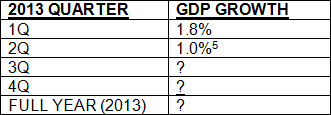This Wednesday, July 31st, the U.S. Federal Reserve Board will release its latest “policy action statement” at 2:00 PM EDT (1:00 PM CDT; 7:00 PM IST). Writing about anything related to the Federal Reserve Board is far outside of my area of experience or expertise, since I am neither an economist nor a politician (something for which I give thanks each morning). However, I can assure us all of six things that are absolutely certain to occur this week, between today and Wednesday: 1) we will be reminded by the market media that the Board is meeting on Tuesday and Wednesday; 2) lots of people will speculate regarding what the outcome of this month’s meeting will be; 3) the markets will “slow up” on Wednesday as that 2:00 PM release approaches (unless someone leaks a summary earlier); 4) the markets will gyrate a bit (perhaps a lot) around 2:00 PM, as it parses and digests the wording of the announcement; 5) after the announcement, pundits and so-called experts will ramble on and on with lots of interpretations or translations of what it all means (since the statements generally only change incrementally each month, adding a word or two here, deleting a word or two there, or changing a particular adjective or phrase within the statement[1]); and 6) there will be as much time speculating on who the next Fed Chairman will be (current speculation mentions Janet Yellen and Larry Summers), since Benjamin Bernanke appears to be on his way out.
Alas, I cannot offer any other assurances of anything Fed-related – including (and especially) what they will say in their statement. What’s more, if I did offer any such assurance, you’d be foolish to trade anything on the basis of it. But that doesn’t preclude me from offering some reasons why I think (as Ron has commented several times since June) that folks jumped too quickly in May and June to the conclusion that Fed bond buying “tapering” would inexorably lead to some imminent and cataclysmic increase in interest rates. So sit back and enjoy this attempt to establish why I think interest rates aren’t zooming upward anytime soon.
Because I can’t think of any better way to do this, I suggest you open the June Fed statement from the Board in one browser (and screen) and move the material below into a second browser (and screen…or any variation you create to view parallel material). You will find that June statement at http://www.federalreserve.gov/newsevents/press/monetary/20130619a.htm .
The first two paragraphs refer to “moderate” economic growth. Of course, absent some “universal standard” of characterizing growth, any particular adjective one uses is subjective. What might seem to the Board to be “moderate” growth might seem “weak” to someone else. It surely would seem “anemic”, for example, to someone in Panama, Myanmar, China, Azerbaijan, or Qatar – all of which averaged growth in GDP at an 8% or higher level between 2003 and 2012 (per the IMF). What word the Board will choose this week is likely to hinge on the first estimate of Q2 GDP (to be released Wednesday morning, but the Board will surely see it on Tuesday). With regard to 2013 growth, by the way, you will all recall that, in June the vaunted U.S. Bureau of Economic Analysis revised its earlier estimate of 1Q GDP growth downward from 2.4%, all the way to just 1.8%.[2]
Late last week, the IMF concluded (following its annual meeting with U.S. officials) that Q2 growth will be lower than originally thought: “Recent indicators point to a sharper than expected slowdown in economic activity in the second quarter. This reflects weakness in inventory accumulation and net exports as well as slower private consumption growth as suggested by retail sales in June.” [3] The IMF continued its gloomy report by reiterating that downside risks are still at work – pointing in particular to the payroll tax increase (initiated in January) and “sequester” spending cuts. To provide you with a fuller context through which to integrate the IMF report, I point out that, earlier in July, Barclays adjusted its earlier projection of 2Q GDP growth downward from 1% to 0.6%.[4]
You might be thinking: “Well, that settles that. Q2 growth will be horrible!” That is a natural and logical assumption. However, in the world of politically shaped economics, things are always more complicated than they seem. There is always the chance that expectations are so low that the “first estimate” released on Wednesday might actually “surprise to the upside”. (Far be it from me to even hint that the number provided Wednesday morning might be “shaded” a bit higher than it should be, in order to make things easier for politicians or the Board!) Let’s just put it this way: if the 2Q estimate is anywhere near as low as Barclays (and others) is expecting, a reasonable person could suggest to Mr. Bernanke and the Board that the adjective “moderate” in front of “growth” is more than a stretch.
There is a key factor here that we need to recall in order to not lose sight of the bigger picture regarding growth and rates. Recall that the Board’s full year forecast of GDP growth was between 2.3% and 2.6%. So let’s do a mini-projection (not precise in any way, just suggestive):
 I am not a PhD in math, but the average person could assume that if the first half of 2013 (H1) averages 1.4% growth, growth during H2 would need to average 3.2% in order for the Board to reach its forecast. (Note that if Q2 growth is as high as 1.4%, H2 growth would need to average 3.0% to reach the forecast.) I will leave it to you to discern the odds of the United States’ economy accelerating growth by that much in Q3 and Q4. In any case, insightful eyes will leap first to the adjective used in paragraphs 1 and 2 to characterize growth!
I am not a PhD in math, but the average person could assume that if the first half of 2013 (H1) averages 1.4% growth, growth during H2 would need to average 3.2% in order for the Board to reach its forecast. (Note that if Q2 growth is as high as 1.4%, H2 growth would need to average 3.0% to reach the forecast.) I will leave it to you to discern the odds of the United States’ economy accelerating growth by that much in Q3 and Q4. In any case, insightful eyes will leap first to the adjective used in paragraphs 1 and 2 to characterize growth!
Moving on to the very important employment data (fyi: Non-Farm Payroll for July will be released on Friday[6]), you recall that the most commonly used unemployment measure has fallen from its October 2009 peak of 10% to 7.6% for June. However, we all know that the discerning observer (ie. anyone who is not a politician currently in office) recognizes that this number is (at best) misleading and possibly (at worst) deceptive (and potentially manipulated). Take a look at this graph (created through the delightfully helpful St. Louise Federal Reserve website[7]). So you can make out all the lines, here is a legend for you (the color of the data series is the color of its line in the graph):
1) Total Unemployment, plus marginal and certain PT workers (this is the “U6” number).
2) Civilian Unemployment Rate (this is the commonly referred to number, coded “U3”)
3) Civilian Labor Force Participation Rate (CIVPART)
4) Civilian Employment to Population Ratio (EMRATIO)
Note that the percentage figures for the first TWO numbers appear on the right of the graph (ie. the current U6 number is 13.8%). The percentage figures for the last two are on the left.
What can we observe from this graph? Well, the critical/skeptical among us could suggest that the U3 number has declined at a slightly steeper pace than the U6 Total Unemployment and Civilian Labor Force numbers. A mathematical analysis of the numbers since 2009 provides a more objective look – namely, the unemployment rate (U3) has been more highly correlated to the declining labor force participation rate (with a coefficient of 0.97) than to any payrolls growth (-0.44). Of course, to all of those who complain that the improvement in unemployment is largely attributable to the numbers of folks “dropping out” of the workforce, politicians (and their press secretaries and economists) reply (paraphrasing here): “Gimme a break. The baby boomers are retiring in droves. Of course folks are “dropping out” of the labor pool – it’s called retirement!”
Don’t roll your eyes now, folks! That is not polite. But there are quite a few metrics that can be used to “counter” the explanations (excuses) of those in government:
1) A large portion of the “recently created” jobs have been in lower wage areas and/or of the part-time variety, skewing the numbers is a fashion that can be misleading;
2) Large numbers of existing employees are experiencing a reduction in work hours, especially within businesses that appear to be engaging in “labor force adjustments” as a result of the financial repercussions of “The Affordable Care Act”.
3) Considering just the 2011 year (for which data is available) among those who filed to initiate receiving their Social Security retirement benefit payments, an unusually large 59% were under age 65 (thereby substantially reducing their potential lifetime benefit and exposing them to the Social Security “earnings test” on any earned income).[8] Since filing for early retirement is not generally an “economically efficient” decision, one could hypothesize that labor force conditions were a significant contributing factor.
Moving along through the policy statement:
a) Paragraph 3 deals with QE plans (ie. bond-buying);
b) Paragraph 4 goes into more detail about Board intent related to QE. Many “experts” predict the Fed will announce the beginning of some “tapering” in September. Others find that hard to justify, given economic data (as we have explained above). However, to be fair to the Fed, there are factors that could be considered in addition to economic growth and unemployment reduction, including:
i) Concern about too many investors “chasing” yield and or risk;
ii) Doubts about the efficacy of QE;
iii) Concerns about the relatively massive size of the Fed’s balance sheet.
c) Paragraph 5 comments on Board expectations regarding the near “zero interest rate policy” (ZIRP) that has been in effect for years now. Keep in mind that Bernanke has repeatedly emphasized that “accommodative” interest rates are here for the foreseeable future (read that “for years to come”).
d) Paragraph 6 reports on how Board members voted on the policy that was finally agreed upon. In June, you can see that the St. Louis Fed head (Bullard) dissented because he feels the need to signal stronger Fed intent to fight deflation (ie. he is a big “easy money” supporter). In contrast, the Kanas City Fed head (George) fears the level of future inflation we may have already “baked” into the economy (leading to her dissent).
INVESTOR TAKEAWAY: No one knows what the Federal Reserve Board will do this week. If anyone claims to “know”, they should either be arraigned on “insider trading” (for knowing non-public information in advance) or ignored. Neither you nor I should make trades in advance that are based strictly on any particular “outcome” from the Fed meeting – unless we know that we are speculating and are fully prepared to lose most or all of the capital used in that trade. However, I hope this “look inside” the always obtuse and arcane Federal Reserve Board “policy statement” has been helpful and informative for you. At least you’ll be better prepared to understand whatever action ensues from this week’s meeting!
Disclosure: The author is not an economist, a politician, or a Federal Reserve Board Governor or staff person, nor is he related to any such person. Therefore, his comments are intended to be strictly educational in nature. Invest and trade carefully, always being aware of your potential risks, as well as your potential rewards.
[1] One of these days, an insightful entrepreneur will realize there is money to be made within the “sleeping aid” space by publishing booklets of past Federal Reserve Board statements – in an easy-to-hold size that fits perfectly on any bedside stand. It is hard to imagine anything else that could be more effective putting one to sleep straight away!
[2] http://www.huffingtonpost.com/2013/06/26/us-gdp-q1-first-quarter-2013_n_3502310.html
[3] http://www.thenewstribe.com/2013/07/26/imf-says-us-q2-growth-less-than-expected/
[4] http://www.zerohedge.com/news/2013-07-10/here-comes-stall-speed-barclays-cuts-q2-gdp-forecast-06
[5] Assuming Barclays was over-pessimistic earlier in July!
[6] Once again, we should assume the Board will get an “early peak” at the NFP number from July.
[7] http://research.stlouisfed.org/fred2/
[8] The early retirement chart comes from: http://www.calvert.com/NRC/literature/documents/el2/ffi-20130729.pdf?article=20506&hq_e=el&hq_m=2639795&hq_l=3&hq_v=000189366f
Related Posts
Also on Market Tamer…
Follow Us on Facebook

 If You'd Invested $1,000 in Shopify Stock 10 Years Ago, Here's How Much You'd Have Today
If You'd Invested $1,000 in Shopify Stock 10 Years Ago, Here's How Much You'd Have Today



